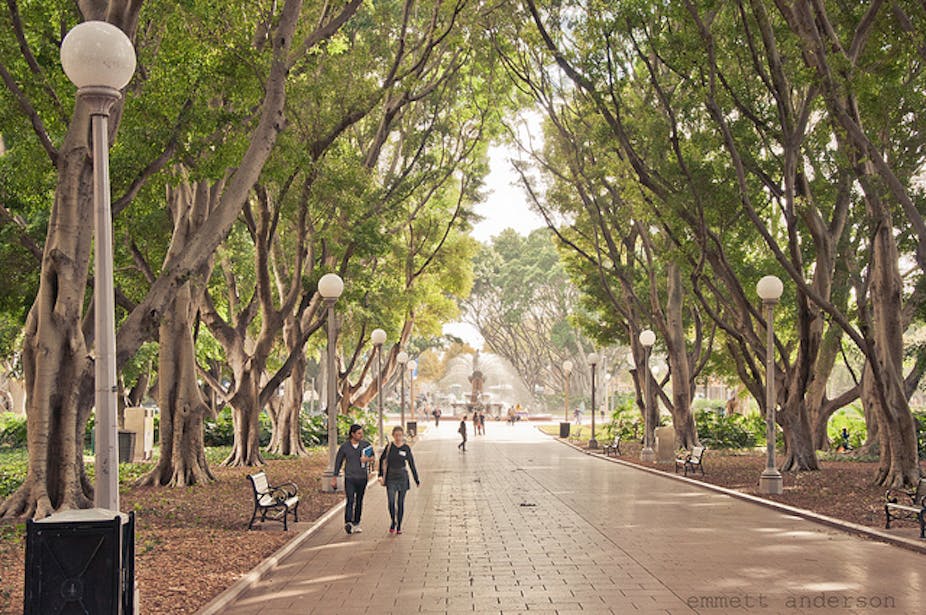Air conditioners across the country are running on full this week as Australia battles a heatwave – but are we missing an obvious, leafy solution?
Trees, which provide shade and act as natural air conditioners, play an important role in helping to create cities that are more resilient to extreme temperatures as the climate warms. In urban areas, however, trees are under considerable pressure.
With last year’s record hot weather, and projections for more frequent and severe heatwaves, this week’s weather may be a sign of things to come.
So why are all the trees removed in so many of our developments?

The population of major Australian cities is expected to double in the next four to five decades. Planned increases in urban density are likely to result in the removal of a significant number of trees from urban areas.
Fewer trees in cities help create urban heat island effects – that’s when buildings and footpaths absorb the sun’s heat and then radiate it back out. Increases of up to three degrees are common and, in extreme cases, night-time increases of up to 12 degrees have been recorded.
Apart from providing shade, trees cool cities through the process of transpiration, in which water is absorbed through the roots and pushed into the air via tiny pores in leaves. Think of them as leafy, misty fans for our cities. It’s no secret they also make urban environments more pleasant, improve water quality and encourage us to get outside for exercise.

Curtin University in Perth recently conducted a study of management of tree canopy in urban infill areas, as part of the CSIRO Urbanism, Climate Adaptation and Health Cluster.
In Perth, where the greatest climate change-related health risk in future will be exposure to higher temperatures, the Western Australia Department of Health has recently upgraded the State Emergency Management Plan for heatwaves. It is clear that planning and development authorities also have an important role to play.
As part of the study, researchers held a workshop with representatives from the planning, development, health and environment sectors.
The workshop revealed a real lack of a coordinated approach to tree management and policies, problems in accounting for the benefits provided by trees and the challenge of managing trees on privately owned land.
Perth’s key strategic planning policy, Directions 2031, calls for a “world class liveable city: green, vibrant, more compact and accessible with a unique sense of place” but there is no city-wide plan for tree management or tree canopy targets, and monitoring is scant.

It’s also more financially rewarding for property developers and builders to remove trees than to leave them in as it frees up space for more buildings to sell to buyers.
Property developers routinely clear entire lots of mature canopy trees prior to redevelopment, putting pressure on local governments to compensate for the loss.
If it is quicker, cheaper and more profitable for trees to be removed and overlooked during the design phase of urban development, this practice will go on.
If, on the other hand, urban planning is improved to include regulations and incentives aimed at retaining trees in the design and development of new lots, our cities could look leafier and feel much cooler in future.
Our researchers recommended that planning authorities develop a tree canopy target and policies to counter the loss of tree canopy associated with urban infill. The city should also have an urban heat island mitigation plan.

It is clear that some local governments have already risen to this challenge with the development of urban forest management plans, tree canopy targets and extensive tree planting programs.
The City of Sydney and City of Melbourne councils, for example, both have urban forest strategies aimed at making these cities greener as they grow.
Such efforts are to be applauded and will be critical to ensure healthy tree canopies in the future. Nevertheless, with a significant proportion of trees located on private land, it is crucial that developers, urban planners and the community are included in the management process.
There are clear reasons to avoid continued urban sprawl and, in Perth at least, strong policy support and relatively modest targets mean the city is likely to meet housing density targets.
But what sort of mid- to high-density suburbs do we want – the kind that is barren, hot and dusty or the leafy, cool and shady kind?
The challenge for most Australian cities, faced with more people and the likely prospect of more heatwaves, is to deliver healthy and comfortable settings.
Factoring trees into urban planning and design is an essential part of development and creating future cities that are climate resilient and pleasant.

